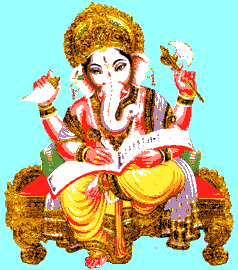Ganesh CyberShrine - page 2 |
|
Lord Krishna said, "As the embodied soul continously passes in this body, from boyhood to youth to old age, the soul similarly passes into another body at death." Bhagavad Gita 2:13 |
 On to Page 3...
On to Page 3...
|
 On to Page 3...
On to Page 3... |
 Genesha is a prominent elephant-headed Hindu god who is worshiped before all great undertakings, including the worship of other gods. Ganesha is a merry god who's always willing to lend a helping hand -- or four!�He's also known as Ganapati and 106
other names that are used mainly in mantras.
Genesha is a prominent elephant-headed Hindu god who is worshiped before all great undertakings, including the worship of other gods. Ganesha is a merry god who's always willing to lend a helping hand -- or four!�He's also known as Ganapati and 106
other names that are used mainly in mantras.
According to most Hindu legends, he is the son of Parvati and Shiva, or just Parvati. The most well known story tells that Parvati created Ganesha from dust and ointment while she was bathing so she could have someone to guard her. Upon discovering this stranger telling him he couldn't see his own wife, Shiva cut the boy's head off. Parvati was so upset that her husband promised he'd put the head back on. However, Shiva could not find the boy's real head, but instead encountered a kindly bull elephant who was willing to sacrifice his life to save the boy. Grateful, Shiva took it, and in return, he granted the old elephant moksha, meaning that he attained Nirvana, thus he would not be reincarnated again. Shiva then gave the boy this new head and named him Ganesha and promised that he'd be worshiped before any undertaking. Other versions of this story said that Parvati made Ganesha from clay because she was lonely and that Shiva wanted an animal head all along. Yet another version says that Shiva created Ganesha as such a beautiful boy that Parvati cursed him and gave him an elephant head. According to a sect of Hinduism known as Ganapathya, Ganesha is the supreme god and the universe itself. When Brahma, Shiva, and Vishnu came into existence, they knew that they were supposed to create (Brahma), destroy (Shiva), and preserve the world (Vishnu), but they did not know exactly how to start the process. Ganesha swallowed them and in his belly, the three gods could see a projection of the universe. After reminding the gods to meditate on aum, he freed them, and the process of creation began. The elephant-headed god's popularity is apparent even outside India. In sculpture, Ganesha had a female form named Ganeshini, but no myths tell about her. In Japan, he was often transformed into elephant-headed twins known as the Kangi-ten. In some Buddhist myths, he was a villain trying to stop the flow of Buddhism. In Tibetan legend, Ganesha was known as Log den, lord of obstacles, and showed the father of Phagpa that his son would spread Buddhism to Mongolia. |
|
 |
 |
 |
 Back to HomePage |